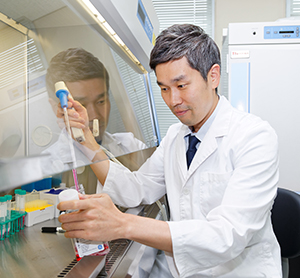Novel Tumor-Suppressive Signaling Mechanism Identified
 Assistant Professor Hyun Woo Park, Department of Biochemistry, Yonsei University
Assistant Professor Hyun Woo Park, Department of Biochemistry, Yonsei University
A collaborative research team gets closer to the possibility of developing a powerful anticancer
This interesting study published in July 2017 in Nature Cell Biology identifying a novel tumor-suppressive cellular signaling mechanism has been conducted in collaboration between laboratories of Professor Hyun Woo Park (Yonsei University, Seoul, Korea) and Kun-Liang Guan (University of California San Diego, USA).
The Hippo pathway has gained tremendous interest over the last decade because of its ability to control organ size and tissue homeostasis, and deregulation of this pathway leads to cancer. Inactivation of core Hippo pathway kinases leads to the activation of the major functional transducer YAP and its paralog TAZ. YAP/TAZ is an oncogenic transcription co-activator that regulates gene expression primarily via interaction with the TEAD family of transcription factors.
The current paradigm for the regulation of this pathway centers on phosphorylation-dependent nucleocytoplasmic shuttling of YAP/TAZ through a complex network of upstream components. However, unlike other transcription factors, such as SMAD, NF-kB, NFAT and STAT, the regulation of nucleocytoplasmic shuttling of TEAD has been largely overlooked.
In the present study, Professor Park identified for the first time that environmental stress promotes cytoplasmic translocation of TEAD via p38 MAPK in a Hippo-independent manner. Importantly, stress-induced TEAD inhibition predominates YAP-activating signals and selectively suppresses YAP-driven cancer cell growth.
Data reveal a novel mechanism underlying nucleocytoplasmic shuttling of TEAD and show that localization of TEAD is a critical determinant of the Hippo signalling output. Professor Park’s group is currently focusing on screening chemical compounds to identify TEAD inhibitors for developing an effective anticancer.
Recommended Articles
Professor Myeong Min Lee
A QUIRKY twist of fate: understanding epidermis cell differentiation in plants
Professor Jihyun F. Kim
Microbial Mercenaries for Plant Disease Resistance Ungrounded